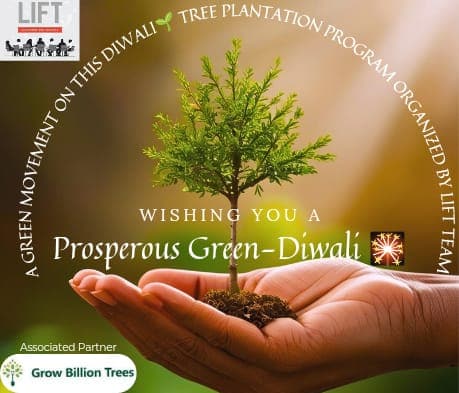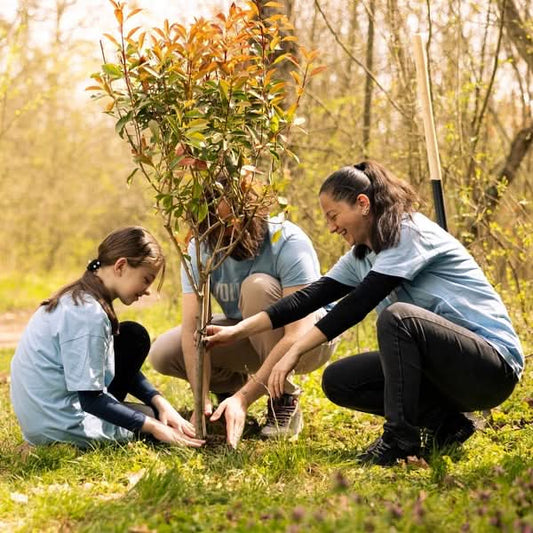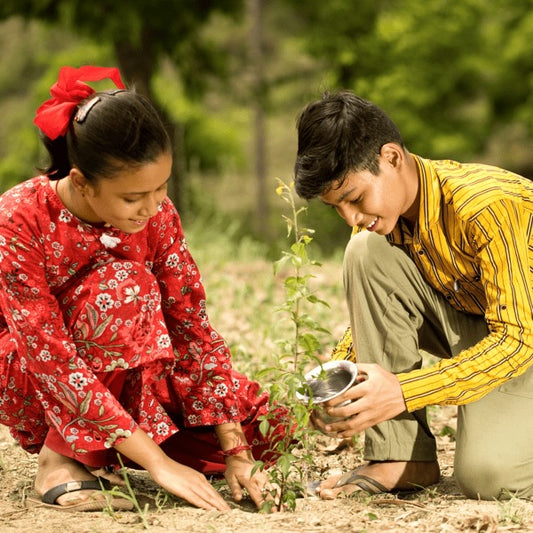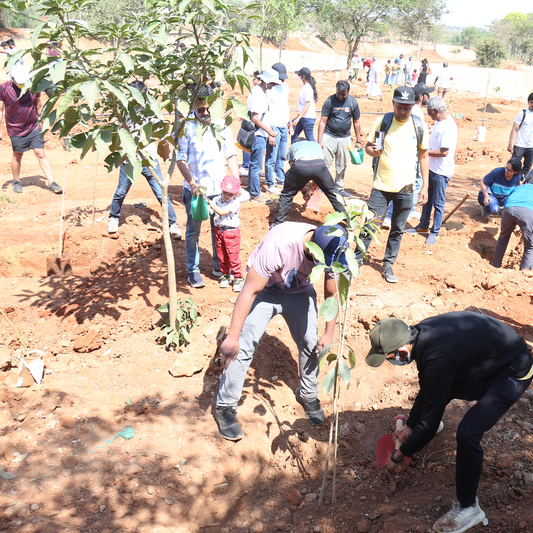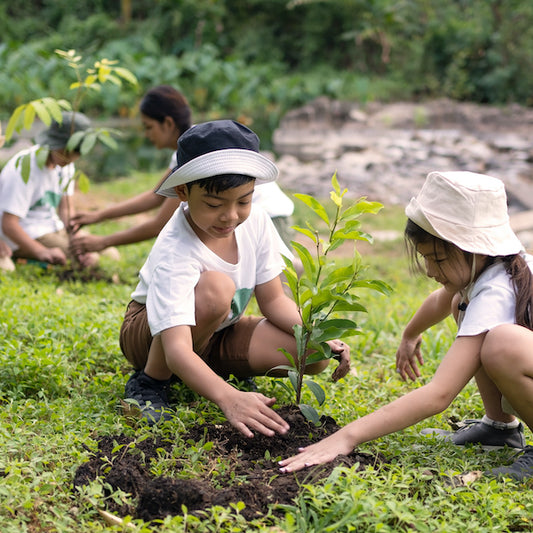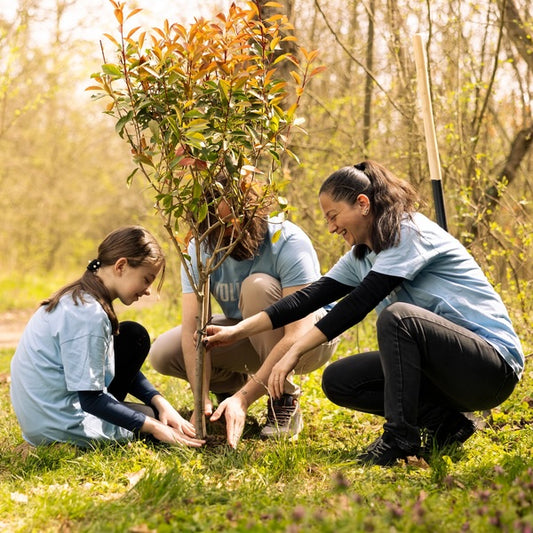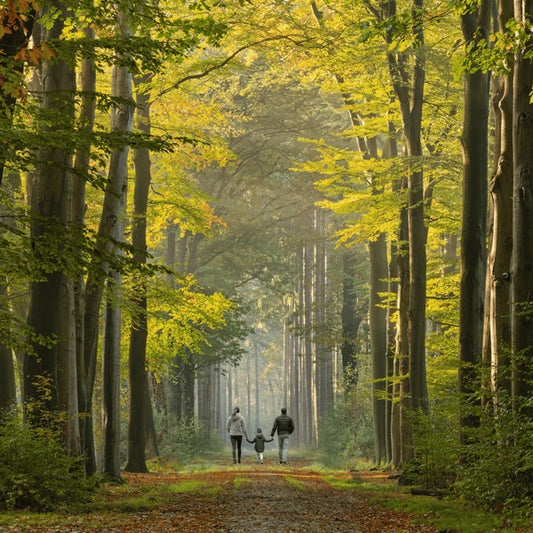Celebrating Sustainability: Rahul Toshniwal's Birthday Initiative
On the special occasion of his birthday, Mr. Rahul Toshniwal took a meaningful step toward environmental sustainability by initiating a tree plantatio Read more
Plantation Site Gallery
Digital Forest
Forest with 101 Trees planted
| Participant | Tree Count | Location | Planting Date |
|---|
Celebrating Sustainability: Rahul Toshniwal's Birthday Initiative
On the special occasion of his birthday, Mr. Rahul Toshniwal took a meaningful step toward environmental sustainability by initiating a tree plantation drive in an urban forest concept. Embracing the philosophy of giving back to nature, he planted trees as a tribute to the planet and a commitment to a greener future.
This initiative focused on creating an urban forest a dense green space within city limits to combat the adverse effects of urbanization. By planting native and fast-growing tree species, Mr. Toshniwal aimed to enhance biodiversity, improve air quality, and provide a natural habitat for local wildlife.
The act not only symbolized personal celebration but also highlighted the importance of individual contributions to environmental conservation. With this thoughtful gesture, Mr. Toshniwal inspired others to join hands in fostering a sustainable, healthier planet, one tree at a time.
Tree Plantation Date
13th April 2024
Plantation Location
R53M+24X Manjha Kala, Uttar Pradesh 224123
Trees Planted
Total Count: 101 Trees
Forest Type: Urban Forest
On the occasion of his birthday, Mr. Rahul Toshniwal embarked on a meaningful tree plantation initiative rooted in the urban forest concept, showcasing his commitment to environmental sustainability. By planting native and fast-growing tree species, this initiative aimed to transform urban spaces into lush, green habitats that combat pollution, enhance biodiversity, and create a serene environment amidst the bustling cityscape. This thoughtful act not only celebrated his special day but also served as a call to action, inspiring others to contribute to a greener, healthier future. Through his dedication, Mr. Toshniwal demonstrated that even individual efforts can create a lasting impact on the planet.
Advantages Of Urban Forest
Improved Air Quality
Urban forests act as natural air purifiers by absorbing pollutants such as carbon dioxide, nitrogen oxides, and particulate matter, while releasing oxygen. Mr. Rahul Toshniwal’s tree plantation initiative contributes to cleaner, fresher air, which is essential for urban residents' health and well-being.
Reduction of Urban Heat Island Effect
The trees planted as part of the urban forest help mitigate the urban heat island effect by providing shade and cooling the surroundings. This reduces the overall temperature in densely populated areas, making cities more livable and comfortable.
Enhanced Biodiversity
The initiative focuses on planting native tree species, which provide shelter and food for local wildlife, including birds, insects, and small mammals. This enhances biodiversity in urban areas, creating a balanced ecosystem within the cityscape.
Carbon Sequestration for Climate Action
Trees in the urban forest absorb significant amounts of carbon dioxide, playing a vital role in mitigating climate change. Mr. Toshniwal’s plantation drive helps offset the carbon footprint of urban activities, contributing to a sustainable future.
Stormwater Management
Urban forests improve water retention in the soil, reducing surface runoff and preventing urban flooding. The trees planted during this initiative will help absorb rainwater, replenish groundwater levels, and prevent soil erosion.
Psychological and Social Benefits
Green spaces in urban areas promote mental health by reducing stress and anxiety. Mr. Toshniwal’s efforts create a serene environment that fosters a sense of community, offering spaces for relaxation and rejuvenation.
Increased Awareness and Inspiration
By celebrating his birthday with a tree plantation drive, Mr. Toshniwal not only contributes to environmental sustainability but also raises awareness about the importance of urban forests. His initiative serves as an inspiration for others to take small yet impactful steps toward environmental conservation.
Contribution to Sustainable Urban Living
The urban forest concept aligns with global goals for sustainable development by improving the quality of life in cities. Mr. Toshniwal’s initiative ensures long-term environmental benefits while making urban spaces more attractive and sustainable.
Activities During Tree Plantation
During the tree plantation initiative, the activity was meticulously organized to ensure smooth execution and optimal results. The site had been prepared in advance, with pre-dug pits ready to receive the saplings. On the plantation day, saplings were planted into the prepared pits, ensuring they were positioned correctly to promote healthy growth. Following the planting, each sapling was carefully watered to provide the necessary hydration for establishing strong roots. This well-coordinated effort not only streamlined the process but also ensured the saplings had a solid foundation to thrive, marking a significant step toward creating a greener and more sustainable environment.
Tree Plantation Purpose
Sustainable Development Goals (SDGs) Achieved Through Rahul Toshniwal's Tree Plantation Initiative in Urban Forest Concept:
1. SDG 3: Good Health and Well-being
Urban forests improve air quality by reducing pollutants and increasing oxygen levels, leading to better respiratory and cardiovascular health for city dwellers. The serene green spaces created also promote mental well-being, reducing stress and fostering emotional health. Rahul Toshniwal's initiative contributes to enhancing the overall quality of life for urban populations.
2. SDG 4: Quality Education
This initiative fosters awareness and education about the importance of trees and sustainability. By engaging individuals and communities in tree plantation activities, it imparts knowledge about environmental conservation and climate change, encouraging responsible behaviors for future generations.
3. SDG 6: Clean Water and Sanitation
Trees play a critical role in improving water retention in the soil, reducing surface runoff, and preventing water contamination. The urban forest initiative helps in replenishing groundwater levels and ensuring cleaner water resources by filtering rainwater naturally.
4. SDG 7: Affordable and Clean Energy
Urban forests contribute to energy efficiency by reducing temperatures in urban areas, which lowers the demand for air conditioning and energy consumption. This indirectly supports the transition to cleaner, more sustainable energy practices.
5. SDG 8: Decent Work and Economic Growth
Tree plantation initiatives like this create employment opportunities in environmental management, from site preparation to plantation and long-term maintenance. Such efforts also encourage sustainable economic activities like eco-tourism and green infrastructure development.
6. SDG 11: Sustainable Cities and Communities
By creating an urban forest, Rahul Toshniwal contributes to making urban areas more livable and resilient. The initiative reduces the urban heat island effect, enhances biodiversity, and creates green spaces that improve the quality of life for city residents, aligning with the goal of sustainable urban development.
7. SDG 12: Responsible Consumption and Production
The initiative emphasizes the use of native and sustainable tree species, promoting responsible resource use. It encourages individuals and organizations to adopt eco-friendly practices, reducing the environmental impact of urbanization.
8. SDG 13: Climate Action
Trees act as carbon sinks, absorbing carbon dioxide and mitigating climate change. This urban forest initiative directly supports climate action by reducing the carbon footprint of urban activities and enhancing the city’s climate resilience.
9. SDG 14: Life Below Water
Although primarily focused on land, urban forests indirectly support aquatic ecosystems by reducing urban runoff and preventing pollutants from reaching water bodies. Improved water quality benefits aquatic life, aligning with this goal.
10. SDG 15: Life on Land
The plantation of trees promotes biodiversity by providing habitats for birds, insects, and other wildlife. It helps in combating deforestation and desertification while improving soil health and creating a balanced urban ecosystem.
11. SDG 17: Partnerships for the Goals
Mr. Rahul Toshniwal’s partnership with Grow Billion Trees has been instrumental in advancing the United Nations’ Sustainable Development Goal 17: Partnerships for the Goals. By collaborating with this visionary organization, Mr. Toshniwal effectively combined individual commitment with organizational expertise to amplify the impact of his tree plantation initiative. Grow Billion Trees provided vital resources such as site preparation, sapling selection, and technical guidance, ensuring the success of the urban forest project. This partnership not only strengthened the execution of the initiative but also encouraged collective action, inspiring others to contribute to environmental sustainability. Together, they showcased the power of strategic alliances in addressing global challenges like climate change, biodiversity loss, and urban sustainability.
ESGs Achieved Through Urban Forest
Environmental (E)
Mr. Rahul Toshniwal’s tree plantation initiative in the urban forest concept directly addresses pressing environmental concerns by promoting biodiversity, reducing carbon footprints, and improving air quality. The planted trees act as carbon sinks, absorbing carbon dioxide and releasing oxygen, thereby combating climate change. Additionally, the initiative enhances soil health, reduces urban flooding by improving water retention, and helps in creating green spaces that mitigate the urban heat island effect. By prioritizing native tree species, the initiative fosters a balanced ecosystem, benefiting both the environment and the local flora and fauna.
Social (S)
The initiative fosters a sense of community by bringing individuals together for a shared goal of environmental conservation. It creates opportunities for awareness and education about sustainable practices, inspiring participants to become stewards of the environment. The urban forest offers long-term social benefits, such as improved mental well-being, access to green spaces for relaxation, and healthier living conditions for urban populations. By involving communities in the plantation process, the initiative strengthens social bonds, promotes inclusivity, and instills a sense of responsibility towards creating a greener future.
Governance (G)
This initiative reflects Mr. Rahul Toshniwal’s commitment to strong governance and accountability in addressing environmental sustainability. By partnering with organizations like Grow Billion Trees, he ensures the project adheres to best practices in tree planting, long-term maintenance, and environmental impact monitoring. The collaboration highlights the importance of aligning personal and organizational efforts with global sustainability frameworks, such as the United Nations’ SDGs. This governance-driven approach ensures transparency, measurable outcomes, and the replication of successful models for similar future initiatives.
Commitment by Grow Billion Trees
Grow Billion Trees is committed to driving sustainable plantation efforts, ensuring every initiative aligns with key environmental objectives and promotes long-term ecological balance. We focus on selecting native tree species that are well-adapted to local ecosystems, ensuring a higher survival rate and stronger environmental impact.
To maintain plant health and longevity, Grow Billion Trees emphasizes continuous maintenance and regular monitoring of the plantations. This approach helps ensure that each tree thrives, contributing effectively to both biodiversity and climate resilience.
Transparency is a core principle in our operations. Clients receive comprehensive reports, including geo-tagging of planted trees, survival rate updates, and ongoing progress reports. This level of openness allows clients to track the direct impact of their contributions, reinforcing trust and accountability.
Through our dedication to sustainable practices, Grow Billion Trees ensures that every plantation project leaves a lasting positive footprint on both the environment and the local communities it serves.
Summary
Mr. Rahul Toshniwal celebrated his birthday with a meaningful and environmentally conscious gesture by planting trees in an urban forest concept to promote environmental sustainability. This initiative focused on combating climate change, enhancing biodiversity, and creating green spaces to improve urban living conditions. By planting saplings and ensuring proper care through pre-prepared sites, Mr. Toshniwal contributed to cleaner air, better water retention, and reduced urban heat. His thoughtful action not only fostered environmental conservation but also inspired others to embrace sustainable practices, making his birthday a memorable step toward a greener future.
Trees for Corporates
Trending
Most Popular
FAQ
What is the importance of tree plantation in urban areas?
Tree plantation in urban areas is essential for improving air quality, reducing heat, and enhancing biodiversity. It helps combat climate change by absorbing carbon dioxide and provides green spaces for people to relax, promoting mental health. By planting trees, cities can reduce pollution, lower the urban heat island effect, and create a more sustainable environment for residents.
How can individuals contribute to urban forest development?
Individuals can contribute to urban forest development by planting trees in their own backyards, participating in local tree planting events, or supporting environmental organizations dedicated to urban greening. Even small actions, such as reducing waste and conserving water, help maintain the health of urban forests and promote environmental sustainability.
What are the benefits of urban forests for cities?
Urban forests provide numerous benefits, including improved air quality, reduced urban heat, enhanced biodiversity, and better stormwater management. Trees in cities help create cooler, more pleasant environments, which can lower energy consumption and improve the quality of life for urban residents. They also provide green spaces for recreation and relaxation.
What types of trees are best for urban forests in India?
Native trees are ideal for urban forests as they are well-suited to the local climate and require less maintenance. Species like Neem, Banyan, Peepal, and Mango are commonly planted in urban spaces due to their resilience, air-purifying properties, and ability to support local wildlife. Choosing native species ensures better sustainability for urban forests.
How does tree plantation contribute to climate change mitigation?
Tree plantation plays a crucial role in mitigating climate change by absorbing carbon dioxide, a major greenhouse gas. Trees act as carbon sinks, storing carbon in their roots, trunks, and leaves. By planting more trees, individuals help offset carbon emissions and reduce the effects of global warming, contributing to a healthier planet.
How can tree plantation improve the quality of life in cities?
Tree plantation enhances the quality of life in cities by providing cleaner air, reducing noise pollution, and offering cooler environments. Green spaces created by trees offer areas for recreation, relaxation, and social interactions, contributing to the physical and mental well-being of city dwellers. A well-planted urban forest also increases property values.
What role do urban forests play in water conservation?
Urban forests play a significant role in water conservation by improving soil absorption and reducing surface runoff. The roots of trees help in retaining rainwater, preventing flooding and ensuring that water infiltrates the soil to replenish groundwater levels. These natural water management systems are critical in urban areas with limited water resources.
Can urban forests support biodiversity in cities?
Yes, urban forests are critical for supporting biodiversity in cities. Trees provide habitat, food, and shelter for various species of birds, insects, and small mammals. By planting trees and creating green corridors, individuals can help maintain and increase biodiversity, making cities healthier and more vibrant ecosystems for wildlife.
What are the challenges faced in maintaining urban forests?
Maintaining urban forests can be challenging due to factors such as limited space, pollution, water scarcity, and human interference. Inadequate funding, poor soil quality, and climate extremes can also hinder growth. However, with proper planning, care, and community involvement, these challenges can be overcome, ensuring the long-term success of urban forests.
How can individuals participate in tree planting initiatives?
Individuals can participate in tree planting initiatives by joining local environmental groups, participating in community tree planting events, or even organizing their own tree planting activities. Many organizations also offer sponsorship programs where individuals can donate for planting trees. It’s a simple yet impactful way to contribute to a greener, more sustainable environment.
Urban Greening
Creating Green Spaces in Cities Urban greening is the art of transforming concrete jungles into vibrant, green spaces. Through tree plantation initiatives, like the one led by Mr. Rahul Toshniwal, cities can breathe easier, literally! Trees reduce air pollution, absorb carbon dioxide, and offer cooler surroundings—perfect for that heat-baked city. Urban greening not only enhances the aesthetic appeal of cities but also contributes to mental well-being. Who doesn’t want a park to stroll through during lunch breaks or to catch some fresh air after a long commute? A little greenery goes a long way in improving our lives. So, next time you see a vacant plot, think of it as potential for urban greening, a place where trees can thrive and cities can bloom!
Green Urban Planning
Designing Sustainable Cities Green urban planning is all about incorporating sustainable practices into city design. Think of it as adding a bit of nature’s magic to urban life! By integrating tree plantation in city blueprints, we can help reduce energy consumption, improve air quality, and even fight climate change. Urban forests are the unsung heroes in this planning, offering cooling effects in hot cities and providing a peaceful retreat amidst the hustle and bustle. Mr. Rahul Toshniwal’s tree plantation initiative is a fantastic example of green urban planning in action—turning his birthday into a green gift for the environment!
Environmental Sustainability
Protecting Our Planet Environmental sustainability means meeting our needs without compromising the ability of future generations to meet theirs. A significant contributor to this is tree plantation! Trees absorb carbon, improve air quality, and provide habitats for wildlife. Mr. Rahul Toshniwal’s tree plantation initiative highlights the importance of environmental sustainability in urban areas. By planting trees on his birthday, he made a lasting contribution to the planet’s health. Whether it’s in an urban forest or a backyard garden, every tree planted helps preserve the environment for future generations. Talk about a birthday gift that keeps on giving!
Air Quality Improvement
The Power of Trees Who knew that trees could be the unsung heroes in the fight for clean air? By absorbing pollutants and releasing oxygen, trees work tirelessly to improve air quality. Mr. Rahul Toshniwal’s tree plantation initiative contributes to cleaner air by planting trees in urban spaces where pollution is rampant. Urban forests are like nature’s air purifiers, providing relief from smog and enhancing the overall health of city dwellers. So, next time you take a deep breath in the park, thank a tree for making that air a little fresher!
Climate Change Mitigation
Trees to the Rescue Climate change is a global challenge, but trees are one of the most effective solutions. Trees absorb carbon dioxide, a major greenhouse gas, helping reduce the impacts of climate change. Mr. Rahul Toshniwal’s tree plantation initiative is a small but powerful example of how individual actions can have a big impact. By planting trees in the urban forest, he’s helping mitigate the effects of climate change in his community. So, whether you’re planting a tree in your backyard or helping out in a local green space, every tree planted is a step toward a cooler, more sustainable planet.
Biodiversity Enhancement
The Tree Effect Biodiversity refers to the variety of life on Earth, and trees are essential in supporting this diversity. Urban forests, like those created by Mr. Rahul Toshniwal’s tree plantation initiative, become home to numerous species of birds, insects, and other wildlife. As trees grow, they provide shelter, food, and a safe haven for different creatures. A healthy urban forest encourages biodiversity, making cities not just greener, but also more vibrant. By planting trees, you’re not just beautifying a space—you’re also helping create a thriving ecosystem right in the heart of the city!
Mental Health Benefits
Trees for the Mind Did you know that spending time around trees can reduce stress, boost mood, and even improve concentration? It’s true! Urban forests, where trees flourish, become spaces for relaxation and mental rejuvenation. Mr. Rahul Toshniwal’s tree plantation initiative not only helps the environment but also provides people with a peaceful refuge from the chaotic urban life. Imagine taking a walk through a newly planted green space—it’s like hitting the reset button for your brain. The next time you're feeling overwhelmed, step into a forest, and let the trees work their magic!
Community Engagement
Planting Together for a Greener Future Tree plantation initiatives are a perfect way to bring communities together. Mr. Rahul Toshniwal’s urban forest project not only benefits the environment but also fosters community spirit. When people come together to plant trees, they’re not just enhancing the city—they’re building bonds. These community-driven efforts instill a sense of pride and ownership in green spaces, ensuring their long-term success. So, why not gather your friends and neighbors for a tree-planting day? It’s a fun way to contribute to the environment while strengthening your community.










